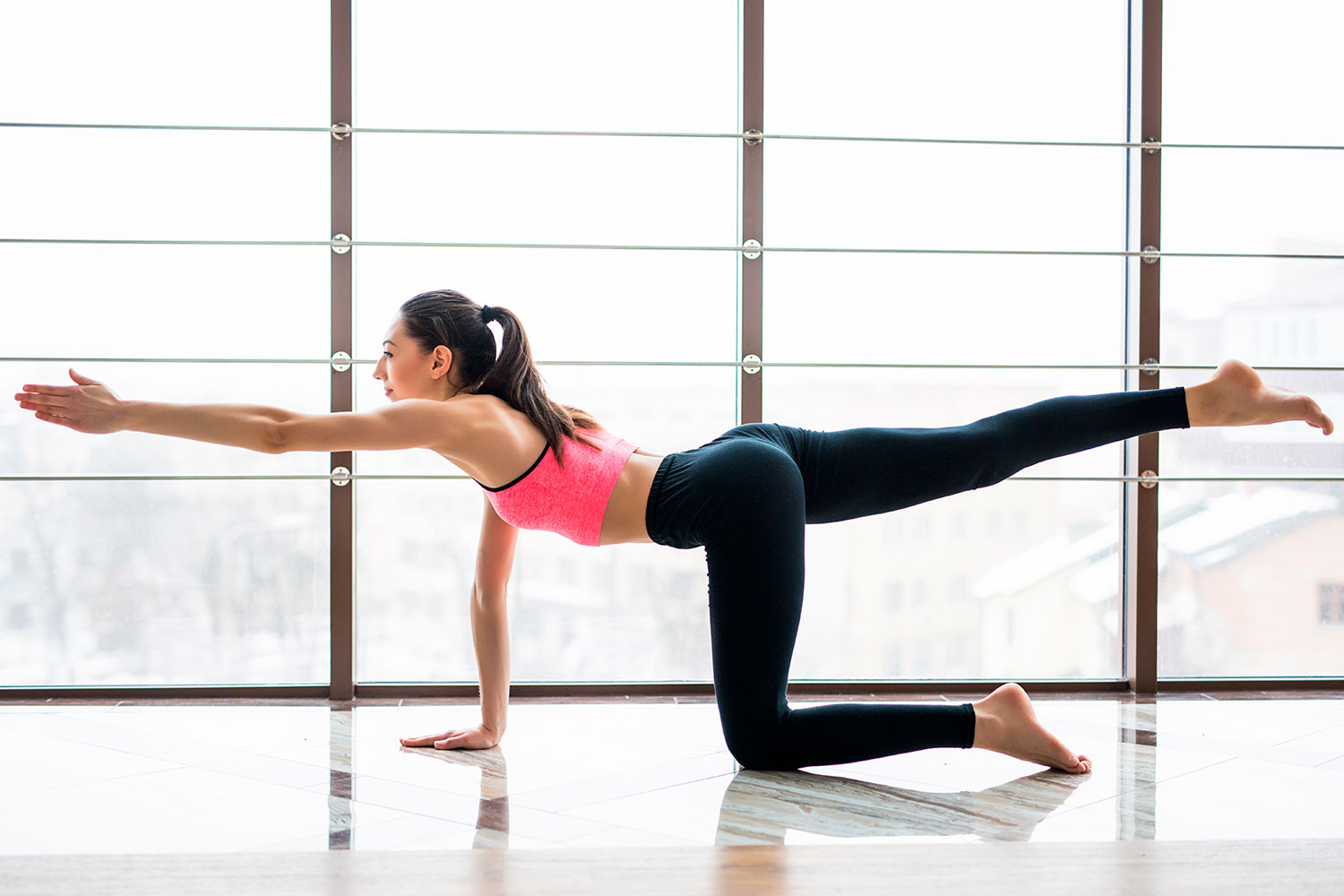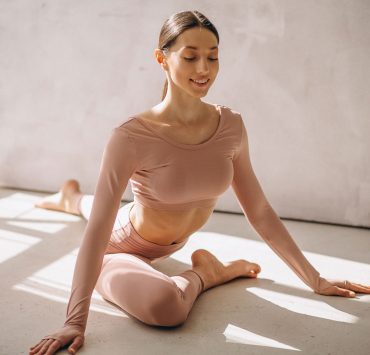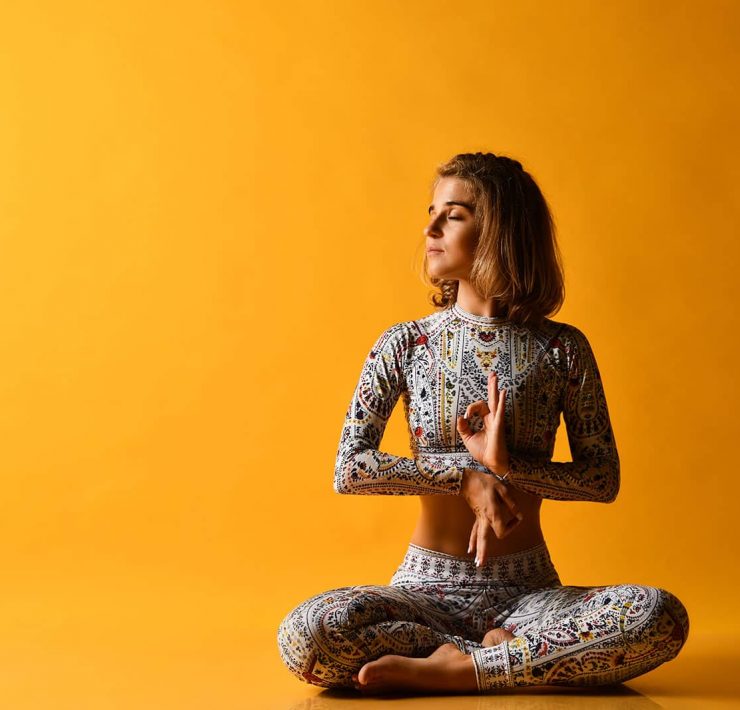
Having been a teacher’s assistant at over 50 yoga teacher…
Practicing yoga is a great way to bring so much joy, spirituality, and athleticism into your life. Even if you have just started a yoga practice (whether it’s using online classes or a yoga studio) you can start rocking a yoga glow with these 20 basic poses. These poses are beginner friendly because they don’t require extensive alignment cues from a professional or any complicated props. Also, keep in mind this list was created so that you can practice all 13 poses in order for a well-balanced beginner yoga routine. Namaste!
Tadasana — Mountain Pose

Mountain Pose is considered a foundation asana in yoga. This pose will be the starting point for many other poses, so it is an important pose to master. At first glance, it might seem like Mountain Pose is a very simple and easy pose, but the truth is having proper alignment in this pose can be a challenge for some. Mastering this pose will bring you great benefits in life – once the position of Mountain Pose becomes automatic, you will find yourself bringing this pose into your everyday life often.
To get Mountain Pose just right, consider these tips:
Practice mountain pose in front of a mirror or take photos of yourself in mountain pose to get a sense of your natural posture. Surprisingly, this can be difficult for some people to see! Remember to practice ahimsa and try not to be hard on yourself – we all have our own postural tendencies, whether it’s slouched shoulders or outwardly turned feet.
Practice Mountain Pose with your back against the wall. Your feet should be parallel but slightly apart. As a general alignment cue, keep your shoulders over your hips, and hips over your ankles.
Anjali Mudra — Salutation Seal

The Salutation Seal is probably one of the most well-known yoga mudras, but most people don’t actually know what it means! This lovely mudra can be done by any yogi, anywhere. You don’t even have to be on your yoga mat to get the benefits of this yoga posture. Usually, the Salutation Seal is combined with seated meditation or in Mountain Pose. In Sanskrit, the Salutation Seal is called “Anjali Mudra.” The world “Anjali” means, “offering.” Even if you have never stepped foot in a yoga class, you can practice this pose:
Place your palms together in prayer position.
Bring your thumbs to your heart and feel all of your energy gather there.
Experiment by moving your hands to the left and right. Notice how the energy in your body shifts as you do so.
(Optional) When you bring your hands to your heart, close your eyes and say “Namaste.” This blessing can help yogis feel the joy of their inner and outer worlds combine.
Incorporate this pose into other yoga postures like Mountain Pose, Tree Pose, and Warrior I.
Vrksasana — Tree Pose

Have you ever wanted to be as tall, graceful, and powerful as a tree? Well, now is your chance! Tree Pose is a wonderful yoga asana that can help you feel more grounded while also improving posture, inspiring confidence, and stretching that tricky psoas. This balancing standing pose can be a little tricky, but with the right props anyone can practice Tree Pose.
Here are some tricks for mastering this one-legged pose as a beginner:
Practice tree pose next to a wall. You can either place your hand on the wall or put the kneecap of your bent leg against the wall. This will help you keep your balance and focus on the main action of the pose, which is stretching and lengthening the psoas.
Imagine an invisible thread attached to the top of your head. Feel it pull upwards to gently lengthen your whole body.
Try practicing tree pose with the toes of your bent leg resting on a yoga block instead of your leg. This is especially helpful if you have knee problems.
Salamba Balanasana — Child’s Pose

“Your body is the child of the soul. You must nourish and train that child.” B.K.S. Iyengar
Ahh, to be a child again! Child’s Pose is a wonderful pose for yogis of all levels as it provides you with rest, relaxation, a nice stretch, and a return to youthful vulnerability. This pose is very versatile – it can be practiced in bed, on your yoga mat, or over a bolster as a restorative posture. Child’s Pose is wonderful for beginners because it can be easily modified depending on your flexibility. If you have trouble bending all the way forward in this pose, bring the floor up to a comfortable level using pillows, blankets, or a yoga bolster.
Trikonasana — Triangle Pose

Because Triangle Pose requires a little extra attention to alignment, it can be one of the harder poses for beginners. But, with a few strategically placed props, this pose will surely become a go-to for everything from fatigue to sciatica. Here are some beginner tips for practicing Triangle Pose:
Practice with your back against the wall. This will help you stay in proper alignment without the help of a teacher and can help you stay upright if you are afraid of falling over!
Practice with a yoga block! This step is crucial for beginners. If you don’t have a yoga block, use a stack of books (and keep stacking them until you have the right height). This will raise the floor up to you so that you don’t loose the benefits of the stretch and collapse the chest forward in this pose.
Imagine drawing your arm out and pivot at the waist before bringing your arm down to the yoga block. This will assist in proper spinal alignment.
Adho Mukha Svanasana — Downward Facing Dog Pose

If you are a beginner yogi, this is the ultimate pose to practice at home! A lot of beginners are embarrassed to practice this pose in class, because it has several alignment cues and can be a little disorienting. You are upside down, afterall! It may be wise to practice this pose in front of a mirror so that you can get a better look at your natural alignment in this pose. Here are some tips that can help you get more comfortable in Downward Dog (it is a resting pose, after all!):
Before you enter the pose, pay close attention to your hands. They should be about shoulder width apart and parallel. Also, make sure your fingers are spread wide and grip that mat with the pads of your fingers.
Make sure your shoulders are outwardly rotated. This means it should feel like the bottom tips of your scapula are coming together.
Keep your elbows and knees slightly bent.
Focus on sending your hips to the sky; this is the action that stretches those legs!
Utkatasana — Chair Pose

One of the major benefits of practicing yoga is that it stretches and strengthens your muscles at the same time. If you are looking to get a nice workout from your yoga practice, this pose is key for beginners! Chair Pose strengthens your legs, core, and arms, but it also works out those little muscles in your feet, ankles, shins, and can help reverse flat feet. If you don’t have the strength or mobility for this pose quite yet, you can practice by placing a chair just barely under your bottom. The key is to activate your muscles, even with the help of the support.
Ardha Uttanasana — Standing Half Forward Bend

If you have ever taken a Vinyasa yoga class, you will be familiar with this pose! This pose is great for beginners because it isn’t too complicated, but it can still give you a lot of great benefits, such as stretching and strengthening your back, ankles, and feet. Avoid beginner mistakes by:
Putting a slight bend in the knees. This will protect your hamstrings from over stretching and prevent you from locking your knees.
Place your hands gently on your shins or the floor – make sure you keep your legs active and don’t push on your shins with your hands.
Bring your belly to your spine to protect your back.
Uttanasana — Standing Forward Fold Pose

If you have had a long day at work, this pose can be a sweet release! To practice, begin in Mountain Pose and then simply fold forward. You can cross your arms over your head or leg them hang down. Practicing with your bottom against a wall (and with your feet parallel, of course) are really the only alignment cues you need to do this pose right.
Phalakasana — Plank Pose

While almost all yoga poses will help strengthen your core in one way or another, nothing is as satisfying as a little core workout using Plank Pose! This pose can be challenging, but there are many modifications that can help you work your way up to the full pose without injury. Some tips to keep in mind:
Place one leg and place your knee on the ground for stability.
Practice with your feet against a wall.
Try practicing side plank with your top leg bent and foot on the floor.
Drop down to your elbows if your arms are tired.
Marjaryasana — Cat/Cow Pose

If you have started practicing yoga for the first time because you have back pain, this pose will be your best friend! This pose is practiced on all fours, so make sure you have proper padding on your knee joints. You can also practice with the upper portion of your hands propped up on a blanket (like a ramp) if you have wrist problems. One tip to keep in mind is to bring your lower belly to your spine to protect your lower back. It should feel like the spine is lengthening in this pose, not as if it is collapsing.
Viparita Karani — Legs Up The Wall Pose

One of the best things you can do for your body is to help your lymphatic fluids move. The lymphatic fluid in your body doesn’t have a natural pump, so it is up to you to get these fluids moving! Doing so can have amazing health benefits too. It is super useful for weight loss and reducing cellulite, and also helps boost your immune system and recovery time from workouts. Your lymphatic fluids include spinal fluid, white blood cells, and intestinal fluid that carries fat and protein. Inverting your body is an excellent way to drain lymph fluid from your legs, but for most beginners, inversions are pretty difficult and can be dangerous. Opt for a pose like Legs Up The Wall, which will relax your body and give you a safe inversion for all ages and abilities.
Savasana — Corpse Pose

It might sound silly, but Corpse Pose is actually one of the most challenging poses in yoga! Especially if you are a beginner, sitting still and quieting your mind can be really hard. But, because this pose does not include many physical challenges, it is a great one for helping beginner yogis get into their practice. Especially the spiritual side of practice! To help yourself ease into this pose, dim the lights in your home, eliminate all distractions, set a timer, and make sure your are comfortable. You can also place an eye mask on your eyes to help quiet your mind and encourage a longer stay in the pose.
Yoga does not remove us from the reality or responsibilities of everyday life but rather places our feet firmly and resolutely in the practical ground of experience. We don’t transcend our lives; we return to the life we left behind in the hopes of something better. Donna Farhi
What's Your Reaction?
Having been a teacher’s assistant at over 50 yoga teacher trainings worldwide, Rebecca Rebecca has a firm grasp on the fine art of yoga and meditation. In her work, she carefully reflects on a vast expanse of knowledge to help others find peace in both body and mind.














